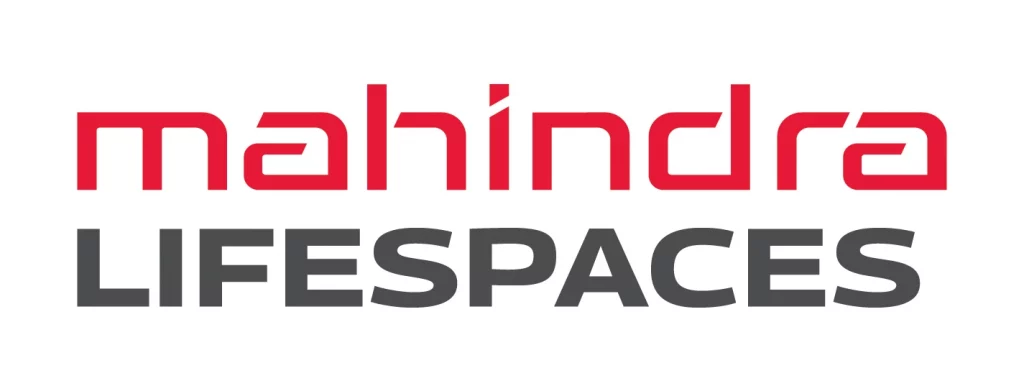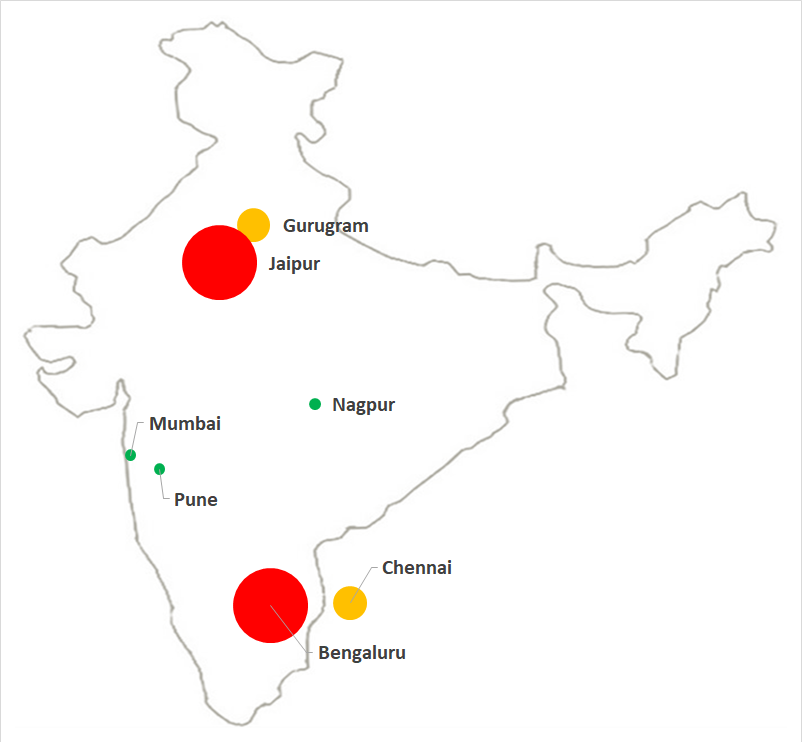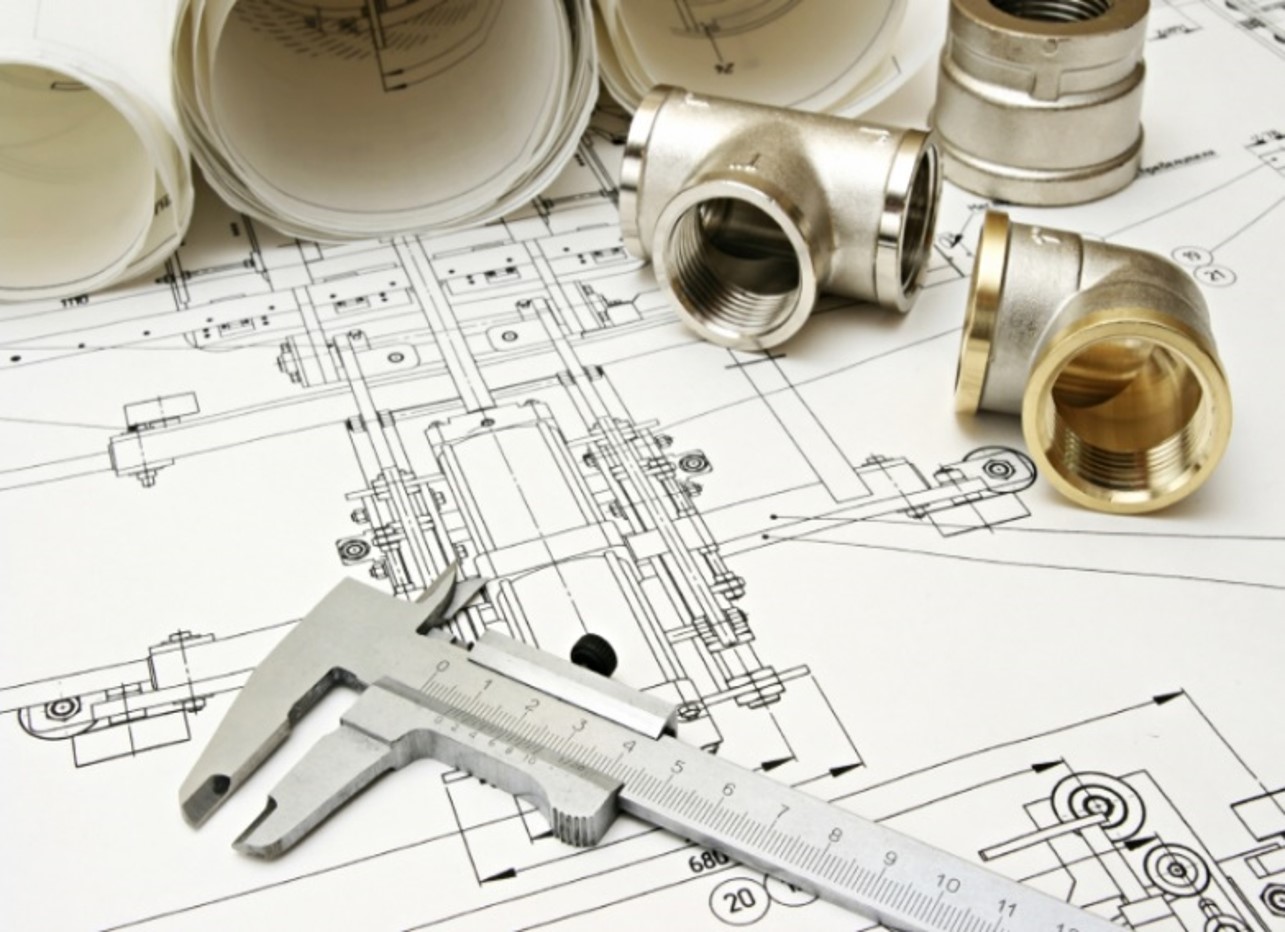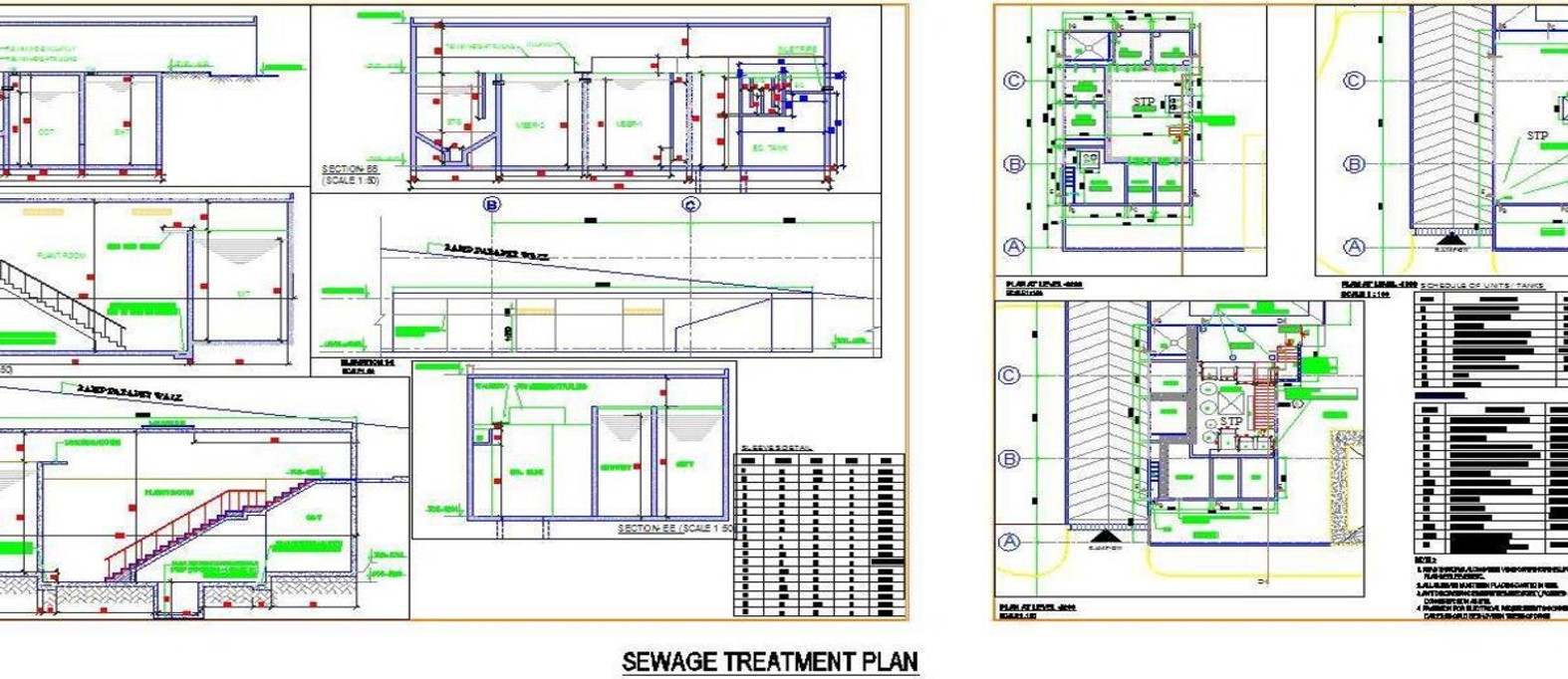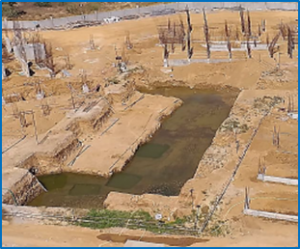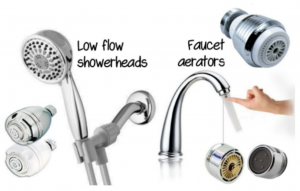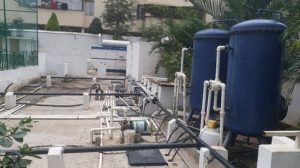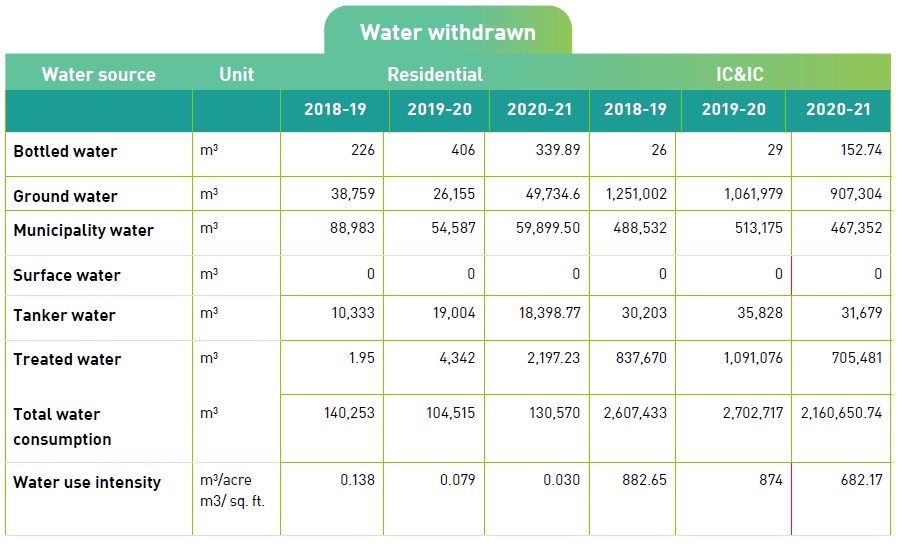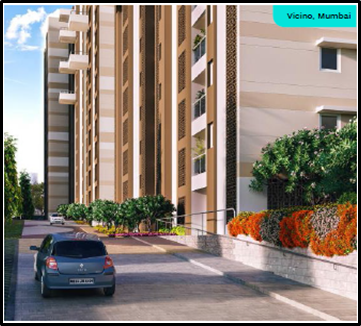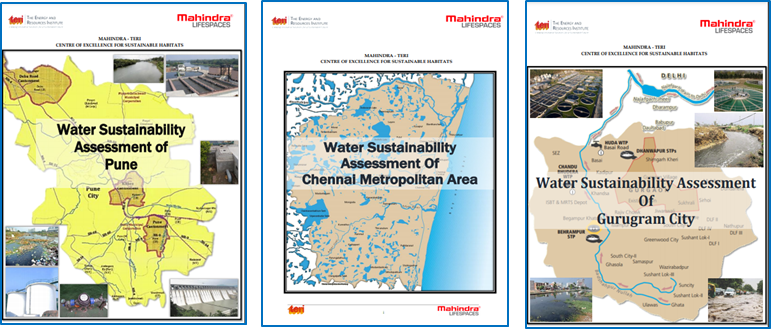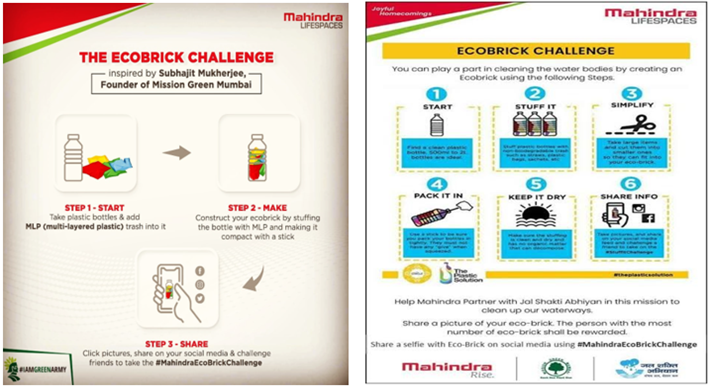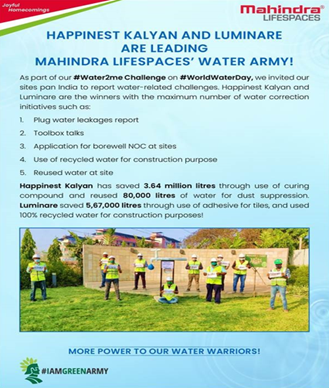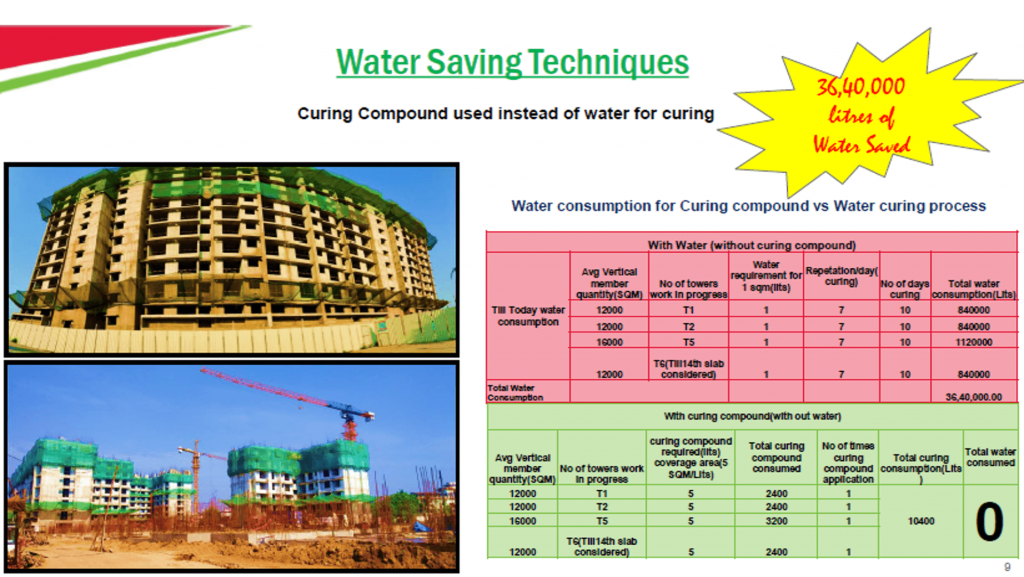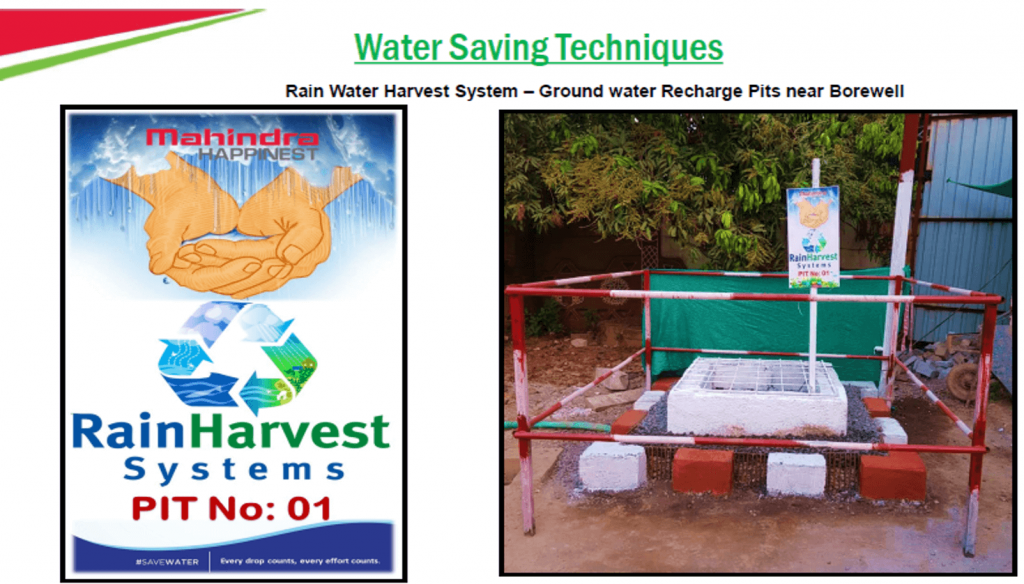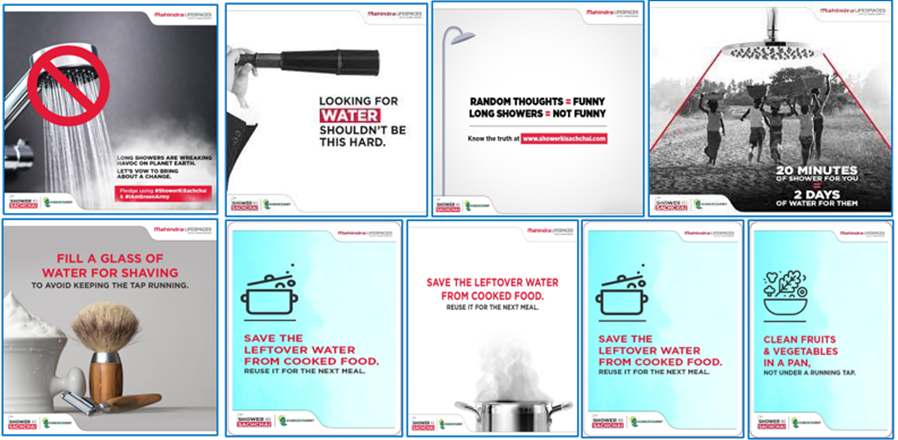
How we are making change
1. Combating water crisis
Water scarcity affects every corner of the world. At the current rate of unsustainable consumption, two-thirds of the world’s population may face water shortages by 2025. According to the Aqueduct Water Risk Atlas of the World Resources Institute, India is ranked 13th among the world’s 17 most stressed countries. With severe water challenges, developers are struggling to meet water demand for construction, landscaping, and customer needs. Measures such as ban on construction or reduction in piped water supply to construction sites have heavily impacted the real estate developers. Such measures can lead to increased construction costs and stalling of projects. However, this also provides opportunities for integration of water efficient infrastructure such as rainwater harvesting to ensure conservation. Hence, Sustainable water management at all phases of construction and use of buildings is the need of the hour.
The changing world scenario has deepened our resolve to contribute to a better world. A world which does no harm to the environment and enhances inhabitants’ health and well-being. For us, sustainable habitats should enable access to local food, in situ farming, in house composting, recycling, with focus on clean air, clean water, and clean energy. Since embarking on our sustainability journey more than a decade ago, we have put in place a number of policies, systems, and processes to measure our impact and minimise our environmental footprint. Our goal has been to maximise energy and water efficiency, reduce air emissions and increase the use of sustainable resources. We have established an integrated systemic approach that straddles all stages of a building’s life cycle and incorporates active and passive design elements in all our building to yield resource efficiency during construction as well as occupancy stage. Additionally, we analyse the resource requirements at different stages of construction phase (i.e. excavation, building of core and shell, and finishing) and our interventions are structured to target the different stages and increase efficiency. We utilise the Integrated Management System to evaluate and improve our environmental performance. The Sustainability team conducts internal audits at periodic intervals for all our sites. Additionally, the MD & CEO also assesses the performance on these parameters every month during projects review meeting.
Water is a critical resource used throughout the lifecycle of the real estate development such as preparation of mortar, mixing of cement concrete and for curing work etc. Even during the occupancy stage, regular availability of good quality water is an essential requirement of our customers. The water quality and availability in rapidly urbanising India is already taking a toll on the water resources. This makes it imperative for us to use water judiciously.
Currently, we used under 0.03 cu. m. of water per sq. ft. of residential area developed, which has reduced by more than 60% from 2019-20. On the other hand, we used 682 cu. m. of water per acre for the development and maintenance of Integrated Cities & Industrial clusters, a decrease of 25% from FY 2019-20. We actively worked on water risk assessment for our businesses and strengthened our water security strategy through risk assessment, reduction in demand, conservation, and rainwater harvesting.
Read more on our water conservation approach & efforts (hyperlink to page 2)
2. Our Water Commitment
3. Our Water Conservation Approach
Water scarcity is one of the greatest challenges of our time. Our freshwater resources are dwindling at an alarming rate. Cities like Chennai faced crippling water crisis this year. The situation is set to worsen as 21 Indian cities are predicted to run out of groundwater by next year. Thus, it becomes imperative that whatever water we have should be used judiciously. Construction activities remain water intensive and depend on reliable supply of water to operate.
At Mahindra Lifespaces, our operations are heavily dependent on the availability of water. It is an essential commodity for preparation of mortar, mixing of cement concrete and for curing work. And access to good quality water is imperative to our customers during the occupancy stage. Along with rapid urbanisation, the increasing demand for water is linked to the various sources of consumption. We are constantly stepping up our efforts in adopting water conservation practices and reducing water consumption in our operations. Unavailability of water would result in delay in work leading to untimely delivery and cost implications.
While our dependence on groundwater for our water requirements exposes us to the risk of rapid rate of groundwater depletion, deployment of efficient water sustainability strategies would allow us to develop future-proof measures drawing examples from leading industry practices. To such an end, we have classified our sites based on water stress into safe, critical and over-exploited. This classification enables us to adopt customised mitigation measures that respect the complexity of each location we operate in & ensures water conservation at every stage of our project. Conservation strategies are truly effective, when embedded in the design stage, to measure and manage water consumption during construction and occupancy over and above ground water recharge in the majority of the sites.
3. Classification of our Sites based on Ground Water Availability
We have constituted two cross-functional teams at Mahindra Lifespaces and Mahindra World Cities to develop, monitor, and evaluate water conservation strategies. The teams evaluate current approaches, site specific challenges, and different business scenarios to identify the potential impact on business arising from water risk. The solutions are identified, carefully analysed for impact, investment and time duration and rolled out in a planned and scientific manner. The teams utilise proven tools such as hydrogeological studies, to determine appropriate locations for developing optimal water recharge locations. In 2020-21, we saw a decrease in water intensity for both residential and IC&IC projects. In 2020-21, there was a reduction in water intensity for both our residential and IC&IC projects. We have started exploring other water source to reduce our reliance on ground water which reflects in reduced usage of groundwater in our operations. We also saw a substantial increase in use of treated water.
All our residential projects have an onsite Sewage Treatment Plant (STP) of varying capacities, which are used for treatment of domestic wastewater. The treated water is reused for the purpose of landscaping, flushing and cooling, within the project thereby making our projects Zero Liquid Discharge sites. At our integrated cities and industrial clusters, wastewater from our customers is treated at an onsite STP, as mandated by the Central Pollution Control Board. Our industrial customers are obliged to install and operate an in-house STP, as mandated by the local regulations. The sludge produced from STPs are disposed as per the local regulations.
We, at Mahindra Lifespaces, take immense pride in being one-of-its kind organisation offering green building solutions to our customers. As a responsible developer, we've institutionalised an approach that straddles the entire lifecycle of a building from site selection, active and passive design, environmentally friendly construction, all the way to occupancy to yield resource savings. Some of key features of our developments include energy-efficient lighting, use of renewable energy, alternative building materials and water recycling and reuse.
4. Site Selection
Land acquisition is a critical phase for our operations. Cross-functional teams carry out extensive environment and/or social assessments as a part of due-diligence process for new acquisition. Water risk is one of the key parameters considered for evaluation. So water is considered a critical component right during the site selection even before designing for water conservation. We use water assessment tools such as climate central, India Water Tool, WWF Water Risk filter, Aqueduct Water tool for an initial assessment of the project site in terms of vulnerability to water risk. Hydrogeological studies are then conducted to at our project sites to understand the groundwater recharge potential as part of our conservation strategy.
For mitigating water stress at our larger formats, i.e., IC&IC, we conducted hydrological studies to inform our interventions, reduced stormwater discharge, strengthened infrastructure for grey water, and rejuvenated Kolavai lake at Mahindra World City, Chennai.
5. Design
Groundwater recharge is integrated into the design through water-efficient plumbing fixtures - Low flow fixtures for optimal water management with infrastructure for rainwater harvesting, treating of domestic wastewater, and reuse of treated water for landscaping and flushing. In our IC & IC business, we are utility service providers for our customers & ensure water supply with dedicated lines for fresh and recycled water.
6. Construction
We reduce our dependence on freshwater use for construction activities through reuse of wastewater post treatment. We have also started harvesting rainwater in our projects to be utilized for construction thereby reducing water related impacts at our sites. We explore & use alternative materials such as curing compound that replaces water and gypsum that uses less water leading to water savings in operations.
7. Occupancy
Along with designing for water conservation in our products, we create awareness amongst our customers on additional ways to conserve water & are currently assessing the potential of installation of water meters in upcoming projects that would help achiev more water savings & bills for our customers.
Read about our water saving initiatives here (hyperlink to page 3)
8. Water Consumption at Mahindra Lifespaces at a glance
As we have zero discharge, our water withdrawal is equal to water consumption
9. Water Saving Initiatives at Mahindra Lifespaces
Water conservation is integrated into our products right from the site selection stage till end-of-life of our products. Along with ensuring water savings in our products, we also encourage research & innovation in water conservation at every stage of our product development resulting in resource & cost savings. Some of the innovative ideas implemented across our projects are listed here.
10. Alternate process for groundwater recharge
Every project site is complemented by a lengthy mix of paved roads, serving the dual purpose of guiding road traffic, as well as effective drainage of rainwater. Our project at Vicino, Mumbai observed an opportunity to use an alternate process for laying pavers without the use of plain cement concrete (PCC) bed. Pavers were used on compacted earth and without PCC bed allowing rainwater to percolate and recharge groundwater, rather than running off to drain. Reducing the runoff into drain also reduces the load on city storm water drainage system. Along with rejuvenating the ground water, paver roads also helped in reducing cost for pathway repairs. It is more efficient to maintain paver road than replacing or repairing concrete pathways. Additionally, paver roads provide better safety for vehicles in terms of anti-skidding.
11. Water Sustainability Assessment at Mahindra TERI Centre of Excellence (MT CoE)
Water related activities at MTCoE included rapid water audit for five properties of Mahindra Lifespaces to assess water efficiency and inform residents about sustainable water use and conservation. City level water sustainability assessments were also undertaken to understand demand and supply scenario in Chennai and Pune & corresponding reports were launched in 2020-21. These reports captured existing water sources and infrastructure, potential risks in water management and the recommendations for sustainable water management.
Read more about MT CoE here (hyperlink to MT CoE page)
12. #MahindraEcoBrickChallenge
As part of our 'Making sustainability personal' program - associate level engagement program on sustainability, through our social media campaign named #MahindraEcoBrickChallenge, we encouraged the community to clean up water bodies by creating an ecobrick. This initiative was appreciated by the Ministry of Jal Shakti.
13. #Water2me Challenge
Water scarcity is a growing concern for our Company. In order to create awareness and encourage action to conserve water, #Water2me challenge was held on World Water Day across our sites. We invited our sites to report on water-related challenges and actions taken to conserve water. #Water2me challenge acted as a platform to enable our sites to come up with solutions to address the water issues. The challenge was organized with the main objective of encouraging our on-site "Water Soldiers" pan India to report water related challenges to "Water Generals" (Project Managers/O&M Heads). Our Water Soldiers truly valued water as an important resource and participated enthusiastically. This challenge instilled a sense of responsibility in our employees towards water that drove saving water intuitively.
Project Luminare and Happinest Kalyan won the challenge for undertaking the corrective measures for water conservation leading to water & cost savings.

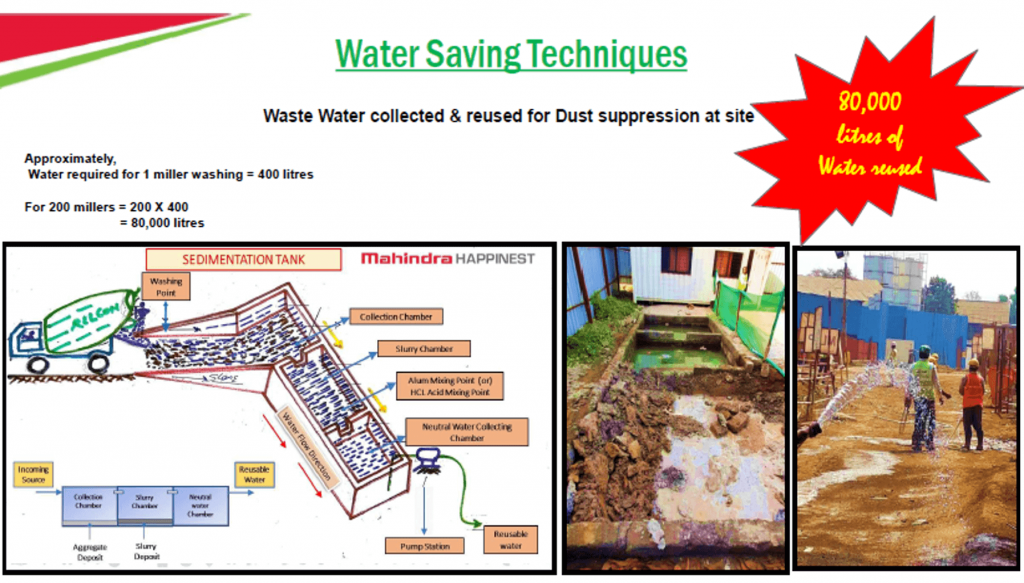
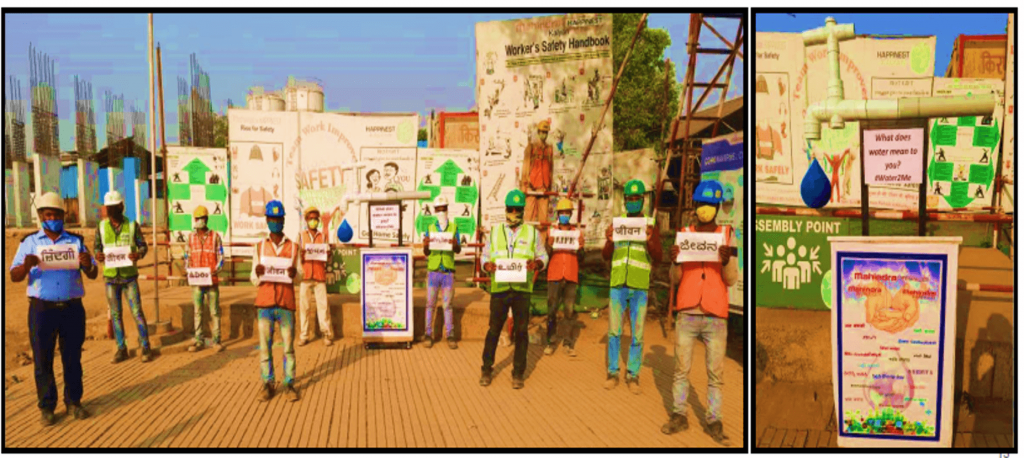
14. Green Hero – Recognising Employee Initiatives
Our IC & IC business at Mahindra World City, Jaipur requires huge quantities of water for landscaping purposes. Majority of the demand was fulfilled through use of water treated by sewage treatment plant on site. However, it was not sufficient in summer months, when the temperatures would go upto 48º C. To cater to the increased water demand, our employee Mr. Mahendra Singh Sisodia restored a water body. Now, the water body attracts local wildlife and migratory birds. Nature enthusiasts and employees flock to this area to indulge in bird watching and photography. Recognising his efforts, Mr. Sisodia was nominated as Green Hero.
15. Customer Engagement on sustainability
As a pioneer of green homes, we embed the message of sustainability in all our marketing and outreach initiatives. We carried out two successful campaigns on sustainability in 2020-21. Through our campaign on 'Shower Ki Sacchhai', we inspired people to bring about a behavioural change and take initiatives to conserve water in their day-to-day lives. The success of the initiative can be gauged by the fact that more than 200 enquiries were received on application of water harvesting techniques. The campaign on #IAmGreenArmy encouraged people to join our sustainability movement. These campaigns generated 86 million impressions and reached 14.1 million people.
Read more about #IAMGREENARMY here (hyperlink to Page on IAMGREENARMY)
